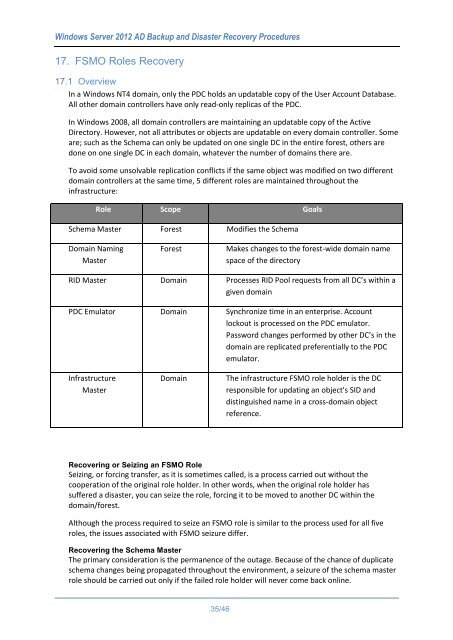WindowsServer2012ADBackupandDisasterRecoveryProcedures_V1.0
You also want an ePaper? Increase the reach of your titles
YUMPU automatically turns print PDFs into web optimized ePapers that Google loves.
Windows Server 2012 AD Backup and Disaster Recovery Procedures<br />
17. FSMO Roles Recovery<br />
17.1 Overview<br />
In a Windows NT4 domain, only the PDC holds an updatable copy of the User Account Database.<br />
All other domain controllers have only read-only replicas of the PDC.<br />
In Windows 2008, all domain controllers are maintaining an updatable copy of the Active<br />
Directory. However, not all attributes or objects are updatable on every domain controller. Some<br />
are; such as the Schema can only be updated on one single DC in the entire forest, others are<br />
done on one single DC in each domain, whatever the number of domains there are.<br />
To avoid some unsolvable replication conflicts if the same object was modified on two different<br />
domain controllers at the same time, 5 different roles are maintained throughout the<br />
infrastructure:<br />
Role Scope Goals<br />
Schema Master Forest Modifies the Schema<br />
Domain Naming<br />
Master<br />
Forest<br />
Makes changes to the forest-wide domain name<br />
space of the directory<br />
RID Master Domain Processes RID Pool requests from all DC’s within a<br />
given domain<br />
PDC Emulator Domain Synchronize time in an enterprise. Account<br />
lockout is processed on the PDC emulator.<br />
Password changes performed by other DC’s in the<br />
domain are replicated preferentially to the PDC<br />
emulator.<br />
Infrastructure<br />
Master<br />
Domain<br />
The infrastructure FSMO role holder is the DC<br />
responsible for updating an object's SID and<br />
distinguished name in a cross-domain object<br />
reference.<br />
Recovering or Seizing an FSMO Role<br />
Seizing, or forcing transfer, as it is sometimes called, is a process carried out without the<br />
cooperation of the original role holder. In other words, when the original role holder has<br />
suffered a disaster, you can seize the role, forcing it to be moved to another DC within the<br />
domain/forest.<br />
Although the process required to seize an FSMO role is similar to the process used for all five<br />
roles, the issues associated with FSMO seizure differ.<br />
Recovering the Schema Master<br />
The primary consideration is the permanence of the outage. Because of the chance of duplicate<br />
schema changes being propagated throughout the environment, a seizure of the schema master<br />
role should be carried out only if the failed role holder will never come back online.<br />
35/46



